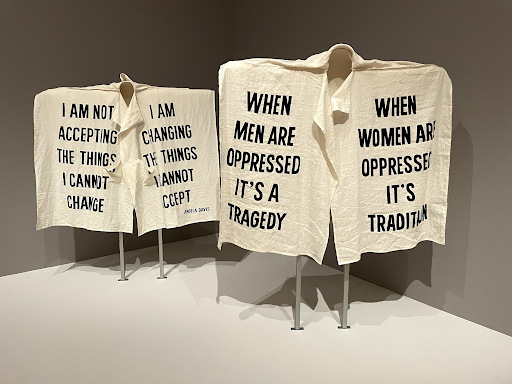“Can you name five women artists?” was the first thing I read when I entered the Women Take the Floor exhibit at the Museum of Fine Arts Boston. And I am ashamed to say that I could name only four. This exhibition text at the entrance immediately acknowledges the gender disparity within the visual arts industry, both through the audience’s perspective, as well as the MFA’s own role in playing into this bias against female artists. Women have been underappreciated and underrepresented as artists, but this exhibition aims to rectify that.
Women Take the Floor consists of more than 200 works of art done by female artists that challenge the history of 20th-century American art as we know it.
The exhibition is divided into seven thematic galleries, each with different artists and works. “No Man’s Land” has works from six artists from different time periods and geographical regions who have shown their personal interpretation of the world around them through landscapes. “Women Depicting Women: Her Vision, Her Voice” shows women representing themselves as well as other women through political, social and activist lenses.
“Women Take the Floor” has its Kahlos and O’Keefes, but it also introduces us to Sonya Clark, Carla Fernández and Erin Robertson — contemporary women artists that are challenging notions of gender, identity and politics.
“I have always reacted to the term ‘woman artist,’ because I so rarely see the term ‘man artist.’ Both terms are frustrating in our era of gender fluidity,” says Art Professor Kimberly Cassibry.
There has been a decent amount of debate on whether an all-women show is a reflection of progress or a demonstration of how far we still have left to go. Does categorizing by gender help show the progress in the art world or only further divide us from real change? The exhibition invites viewers to reflect on their thoughts and write them down. One of the anonymous note cards had a very poignant take: “What if there were a world where my daughter wasn’t amazed by an all-women show?”
Professor Cassibry considers this show a good thing. “Gender is an aspect of identity that curators need to track as they look for omissions and biases in their collections. This is a point that the feminist activists the Guerilla Girls continue to make. So, yes, I think that this kind of exhibition can be helpful in taking stock of where we stand so that we can move forward,” she said.
Art Professor Daniela Rivera says that she still sees it as a gray area. On one hand, the title “Women Take the Floor” drew her to the exhibition because of how catchy it is, but Professor Rivera also sees the categorization based on gender as slightly reductive for these works. “When I am invited to group shows and my work is curated in things, I’ve had the experience of feeling uncomfortable when instantly grouped together with other Latin American artists, because that kills the possibility of participating in other discourses. When you’re trying to establish dialogues from your point of view even as a Latin American or a female, you want it not just with your peers but also with people who are saying something similar from a completely different perspective,” she said.
“Women have always been creative, but what they have produced has not always been considered collectable or worthy of exhibition,” said Professor Cassibry. Her personal favourite was “Beyond the Loom: Fiber Art as Sculpture,” an exhibit that featured fibre arts, which are typically underrepresented in major museums. “The works in that gallery were bold, abstract and monumental, especially Bamian and Amiyose V. I also liked that the ‘1940s and 1950s’ gallery included furniture designed by Ray Eames and her partner Charles.”
The entrance to the exhibition tells us that less than 5% of all acquisitions during the past 10 years (or 3,800 works) are from known female-identifying artists. And most of the exhibits pulled out for “Women Take the Floor” were simply kept in storage.
Professor Rivera said she finds it frustrating that the only context these works are shown in are the Women Take the Floor exhibit, but she is hopeful that they will be amplified more later now that more people have seen them.
Professor Cassibry agrees. “Often it just didn’t fit in with the story a curator wanted to tell in a gallery. And that can be important to see — the art that hasn’t fit into the story so far.”




